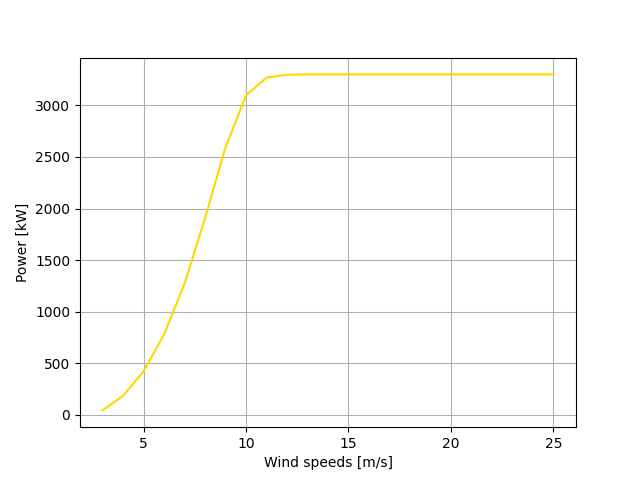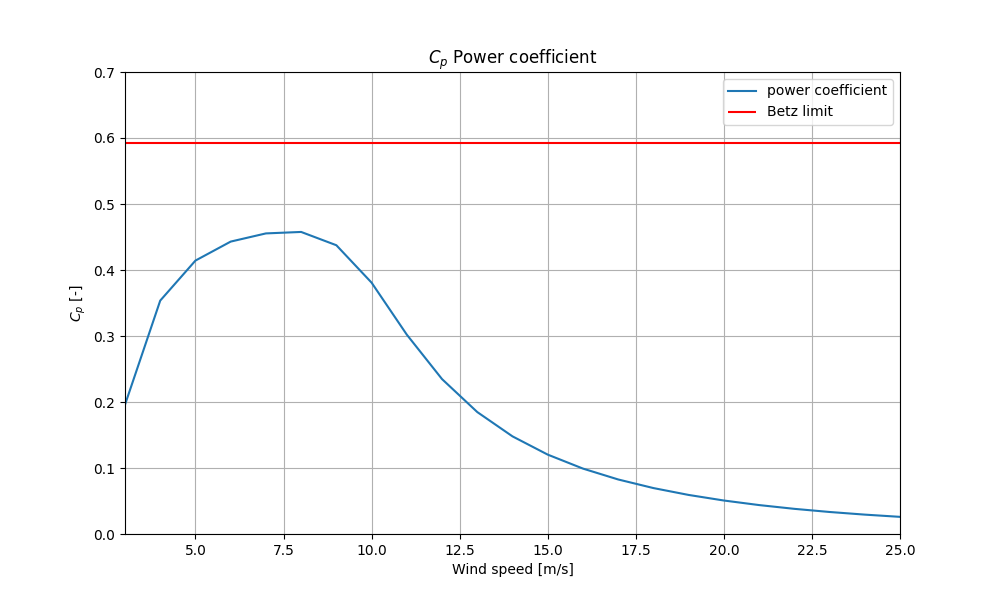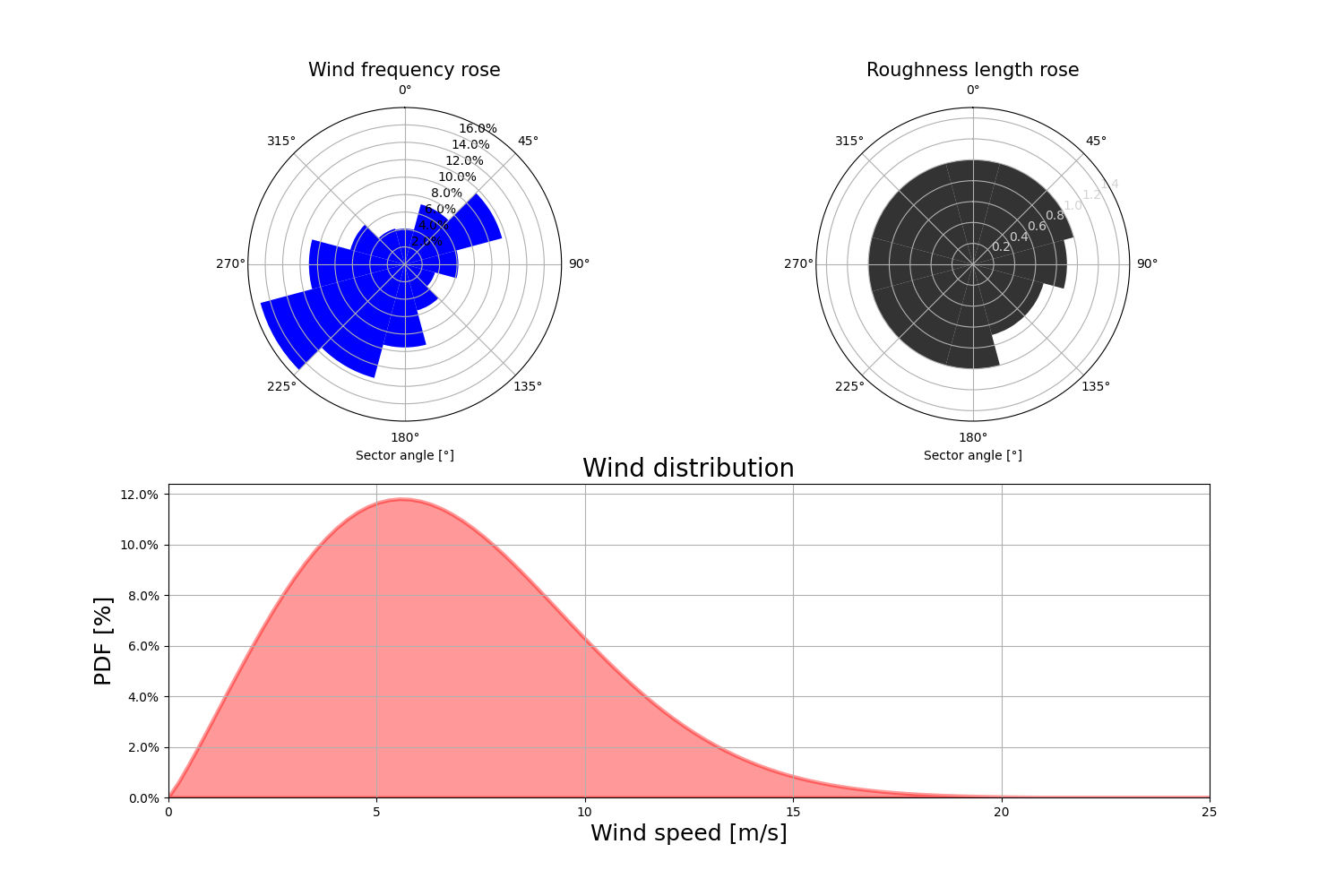Getting Started#
Installation#
wind-stats can be installed via pip from PyPI.
Wind Turbine#
Wind turbine can be defined as follow :
In [1]: from wind_stats import WindTurbine
In [2]: from wind_stats.units import units
# https://en.wind-turbine-models.com/turbines/1467-siemens-swt-3.3-130-ln
# Power curve data
In [3]: wind_speed = [3, 4, 5, 6, 7, 8, 9, 10, 11, 12, 13, 14, 15, 16, 17, 18, 19, 20, 21, 22, 23, 24, 25] * units("m/s")
In [4]: power = [43., 184., 421., 778., 1270., 1905., 2593., 3096., 3268., 3297., 3300., 3300., 3300., 3300., 3300., 3300., 3300., 3300., 3300., 3300., 3300., 3300., 3300. ] * units.kW
In [5]: wind_turbine = WindTurbine("Siemens SWT-3.3-130 LN",(wind_speed, power), 130, 135)
In [6]: wind_turbine
Out[6]: <WindTurbine>(Siemens SWT-3.3-130 LN, 3.3 MW, height:135 m, diameter:130 m)
In [7]: In [1]: import matplotlib.pyplot as plt
...: ...: plt.xlabel("Wind speeds [m/s]")
...: ...: plt.ylabel("Power [kW]")
...: ...: plt.grid()
...: ...: plt.plot(wind_speed.m, power.m, color="gold")
...:
Out[7]: [<matplotlib.lines.Line2D at 0x7f2e32fe7f10>]

In [8]: wind_speed, cp = wind_turbine.get_power_coefficients()
...: plt.figure(figsize=(10,6))
...: plt.plot(wind_speed, cp, label="power coefficient")
...: plt.hlines(16/27, 0, 25,color = "red", label="Betz limit")
...: plt.title("$C_p$ Power coefficient")
...: plt.xlabel("Wind speed [m/s]")
...: plt.ylabel("$C_p$ [-]")
...: plt.xlim(3, 25)
...: plt.ylim(0, 0.7)
...: plt.grid()
...: plt.legend();
...:
In [9]: plt.show()

Wind Distribution#
To evaluate energy production, one need to know the wind distribution at the site the wind turbine is going to be installed.
To do that wind-stats is making things easy for you with using WASP compatible files that can be downloaded with Global Wind Atlas.
GWC (Global Wind Climate) File can be downloaded through the Global Wind Atlas or with get_gwc_data function.
Note
The generalized wind climate file, also known as a wind atlas file, contains the sector-wise frequency of occurrence of the wind (the wind rose) as well as the wind speed frequency distributions in the same sectors (as Weibull A- and k-parameters).
Important
You need to install requests to use get_gwc_data function.
See also
More options are available to generate wind distribution.
In [10]: from wind_stats import get_gwc_data
In [11]: latitude, longitude = 48.4569 , 5.583
In [12]: gwc_data = get_gwc_data(latitude, longitude)
In [13]: gwc_data
Out[13]:
<xarray.Dataset>
Dimensions: (roughness: 5, height: 5, sector: 12)
Coordinates:
* roughness (roughness) float64 0.0 0.03 0.1 0.4 1.5
* height (height) float64 10.0 50.0 100.0 150.0 200.0
* sector (sector) float64 0.0 30.0 60.0 90.0 ... 240.0 270.0 300.0 330.0
Data variables:
A (roughness, height, sector) float64 5.75 6.79 7.73 ... 6.31 5.83
k (roughness, height, sector) float64 2.025 2.084 ... 1.916 2.057
frequency (roughness, sector) float64 3.72 5.19 9.26 ... 10.25 6.12 4.17
Attributes:
coordinates: (48.444, 5.583)
Or with a downloaded GWC file through Global Wind Atlas interface:
In [14]: from wind_stats import GWAReader
In [15]: with open("gwa3_gwc_j9mubhkw.lib") as f:
....: gwc_data = GWAReader.load(f)
....:
Weibull A- and k-parameters & frequencies are interpolated provided hub-height & roughness length for each wind sector to generate the Weibull wind distribution.
See also
Roughness length user guide can help you evaluate roughness length at your site.
In [16]: from wind_stats import WindDistribution
In [17]: import matplotlib.pyplot as plt
In [18]: roughness_lengths_distribution = [1, 1, 1, 0.9, 0.7, 0.7, 1, 1 , 1, 1, 1, 1]
In [19]: wind_distribution = WindDistribution.from_gwc(
....: gwc_data,
....: roughness_lengths_distribution,
....: wind_turbine.hub_height.m
....: )
....:
In [20]: wind_distribution
Out[20]: <WindDistribution>(type: weibull_min, mean: 6.7003 m/s)

Site#
A Site is defined with GPS coordinates (latitude, longitude) & wind distribution.
In [21]: from wind_stats import Site
In [22]: site = Site(latitude, longitude, wind_distribution)
Tip
You can generate site from Global Wind Atlas wind distribution :
from wind_stats import Site
Site.from_gwc(latitude, longitude, roughness_lengths_distribution, height)
After defining our site we can now evaluate our annual energy output:
In [23]: annual_energy = wind_turbine.get_annual_energy_production(site).to("MWh")
In [24]: print(annual_energy)
11679 MWh
In [25]: energy = wind_turbine.get_energy_production(site, 3 * units.months).to("MWh")
In [26]: print(energy)
2919.8 MWh